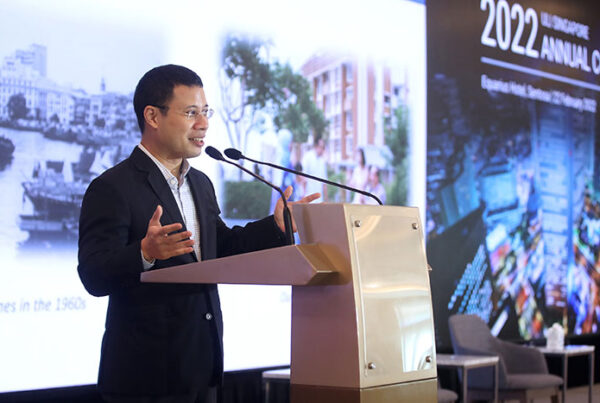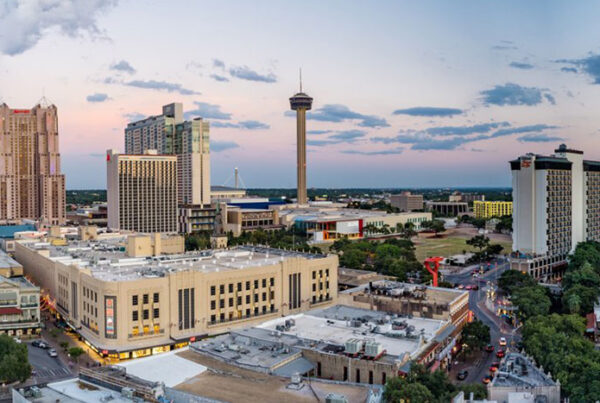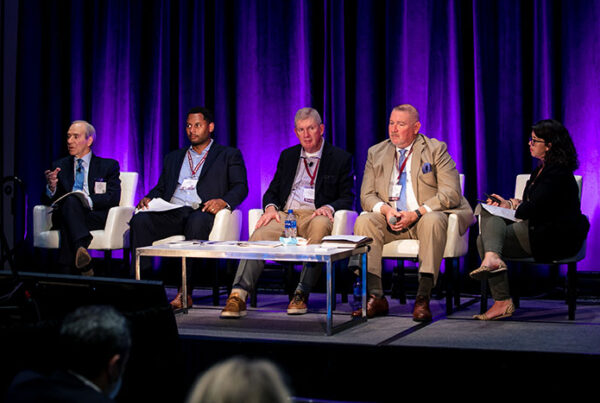The ULI Terwilliger Center for Housing has announced 16 finalists for this year’s Jack Kemp Excellence in Affordable and Workforce Housing Awards, which honor exemplary developments that ensure housing affordability for people with a range of incomes. The award recognizes efforts by the development community to increase the supply of housing affordable to households earning less than 120 percent of the area median income (AMI). The winners will be announced in October.
This year’s finalists, selected from a record number of applications, are:
- A.O. Flats at Forest Hills, Jamaica Plain, Massachusetts—a highly sustainable LEED Platinum–certified, transit-oriented, mixed-income community built on a once-vacant Massachusetts Bay Transit Authority site. The building has 78 apartments, 1,600 square feet of retail space, and 2,500 square feet of community space to host resident amenities that include a business hub, fitness room, lounge, outdoor play area, dog walk, and bicycle storage. The development prioritized racial equity and inclusion through its contracting and hiring goals, and of the project’s total construction contract value, 38 percent went to Minority Business Enterprise firms and 13 percent to Women Business Enterprise firms.
- Arlington Drive Youth Campus, Tacoma, Washington—a development providing housing and services for youths and young adults who are experiencing homelessness, making the transition from foster care, or on the threshold of homelessness. The campus consists of a crisis residential center and a 58-unit apartment complex for homeless young adults, with about 30 percent of the residents being parents of babies or toddlers. The adjacent apartment complex provides apartments for previously homeless 18- to 24-year-olds. The Social Impact Center of the YMCA of Greater Seattle provides on-site supportive services. The young adults were included in the design process for the development of Arlington Drive Apartments.
- Ash+River Townhomes, Boise, Idaho—a development offering 34 units of workforce/moderate-income housing near the city’s fast-growing downtown. The design pays homage to the adjacent historic Hayman House, the 60-year residence of Emma Hayman and now a cultural site honoring the history of Black residents in the neighborhood. The development includes townhouses and flats, along with retail space, open space, and pedestrian-oriented amenities that include a local coffee vendor. The community is certified LEED Gold, and its energy-efficient construction translates into lower utility bills and healthier homes for residents.
- Bayshore Villas, San Juan, Puerto Rico—the first mixed-income development on the island, offering 174 apartments for market-rate, moderate-income, and low-income households. The development includes commercial space and a club room and fitness center, and was built to withstand tropical storm and allow residents to safely shelter in place.
- Casa Arabella, Oakland, California—an affordable 94-unit transit-oriented development adjacent to the future Fruitvale Bay Area Rapid Transit (BART) station. Residents are further supported by being provided with free transit passes. As a family-oriented development, Casa Arabella includes flats and townhouses plus a community room, multiple courtyards, a play area, bicycle parking, and a community garden.
- Corsair Flats, Alameda, California—the first building constructed on the Alameda Point site master development of the historic former Naval Air Station. It offers 60 apartments for low-income seniors, including veterans. The building includes many resident amenities and sustainability features, including bioretention water filtration systems to reduce energy costs for residents. Panelized floor and wall systems resulted in a speedy construction timeline of 15 months.
- Gardner House, Seattle, Washington—a development providing 95 apartments for low-income and formerly homeless families. The ground floor hosts the Allen Family Center, which integrates education, housing, and employment resources for families and individuals while also offering a children’s play area, community room, resource room, classroom, and community kitchen. The building is located one block from a light-rail station, has achieved Evergreen Sustainable Development Standard certification, and displays a seven-story mural painted by Kenji Stoll.
- Harlow Apartments, Washington, D.C.—a large mixed-income and mixed-use community in the Arthur Capper/Carrollsburg redevelopment in the Capitol Riverfront neighborhood, with 20 percent of the 179 apartments set aside for very-low-income households. The building has many sustainable design features, including the District’s first shared Best Management Practice for stormwater management.
- La Placita Cinco, Santa Ana, California—a development that replaced an underused surface parking lot and gas station with a neighborhood service–inclusive community that includes affordable housing, outdoor amenities, and a commercial center. In addition to providing much-needed housing, this development transformed an impermeable surface with landscaped areas and sustainable stormwater management facilities that retain and treat all runoff on site, as well as a new tree canopy and white roofs. New walkways and curb extensions also increased pedestrian safety and neighborhood connectivity.
- Livonia Avenue Initiative, Brooklyn, New York—a development offering 299 affordable apartments and commercial space in four buildings along the 3 Train line. The buildings are oriented so as to mitigate the sound and vibration from the subway while enhancing the streetscape below the elevated train. This LEED Silver development uses energy recovery ventilators (ERVs) for filtered fresh air in the corridors and provides resident amenities that include on-site fitness centers and outdoor terraces.
- Orchards of 82nd, Portland, Oregon—a family-oriented affordable development that prioritizes housing Black/indigenous/people of color families. The building includes a multicultural space run by the Asian Pacific American Network of Oregon. The development is also home to ROSE Community Development’s Baby Booster program, for which housing new and expecting families is a goal. Two-thirds of Baby Booster families are Black or indigenous, the two populations that experience the greatest racial disparities in birth and outcomes.
- Pendana at West Lakes, Orlando, Florida—a development that revitalized the West Lakes community adjacent to downtown Orlando. The 320 apartments include family apartments and independent-living senior apartments, with rents ranging from affordable for low-income households to market rate. The community had consisted of hundreds of vacant and dilapidated apartments, and the community’s transformation includes community health and wellness amenities, a new early childhood education center, a new Boys & Girls Clubs of America facility, and a new elementary school.
- The Smile in Harlem, New York, New York—a large building with more than 200 units of mixed-income housing. The building’s facade gently slopes inward like a draped curtain, deviating from the hard, linear street edge. The Smile transforms a traditional street, creating visual connections between the streets to form a more cohesive neighborhood experience for residents and locals. Amenities include a rooftop with dining space and grills, a large screening area for movies, and views of Central Park and the Manhattan skyline.
- The St. John, San Antonio, Texas—the adaptive use of the former St. John’s Seminary College. Now home to 228 apartments, the property is within walking distance of the San Antonio River Walk as well as employment and commercial centers. It also is adjacent to a UNESCO World Heritage site whose archeological mapping and preservation created challenges but also a unique opportunity to preserve a site with substantial historical and cultural significance while also delivering a high-quality housing project that will act as a catalyst for future development and economic growth. Further, the two Latino development team leaders reflect the community served and were directly involved in the community meetings and outreach.
- Stylus and Siena Affordable Apartments at Civita, San Diego, California—two large buildings providing affordable apartment options for seniors and families. Each community has its own club room with kitchen, a computer lab, courtyard areas with picnic and grilling areas, and a fitness center, and it is located next to an award-winning park. The design includes state-of-the-art reclamation technology in the subterranean garage engineered to treat 8 million gallons of effluent a month to provide water for irrigation. The community has a free shuttle connection to the San Diego Trolley, and a new elementary school will open next year.
- Villas on the Park, San Jose, California—the first 100 percent permanent supportive housing project in downtown San Jose, providing enhanced on-site services that include individual and group therapy, individual and group rehabilitation, crisis response, and case management. The building’s architectural style is rooted in trauma-informed design principals.
“Congratulations to all of this year’s Kemp Award finalists, whose commitment and creativity have enabled communities to meet critical housing needs in a uniquely challenging environment,” said Christopher Ptomey, executive director, ULI Terwilliger Center for Housing. “Each of these projects demonstrates replicable approaches to delivering mixed-income residential developments, an important tool for meeting cities’ workforce housing needs.”
ULI established the Jack Kemp Excellence in Affordable and Workforce Housing Awards in 2008, naming the award in memory of Jack Kemp, former secretary of the U.S. Department of Housing and Urban Development, who had served as a Terwilliger Center national advisory board member.
The award is given annually to affordable and workforce housing developments that represent outstanding achievements in several areas, including affordability, innovative financing and building technologies, proximity to employment centers and transportation hubs, quality of design, and involvement of public/private partnerships. Developments competing for the Kemp Award may be fully affordable, with all units designated for low- to moderate-income residents, or they may contain a mix of affordable and market-rate units.
The jury is chaired by Ron Terwilliger, founder of the ULI Terwilliger Center and chairman of Terwilliger Pappas Multifamily Partners.
Other jury members are Payton Chung, managing partner, Westover Green, Washington, D.C.; Dennis Daniels, architect and project manager, Wier Boerner Allin Architecture, Nashville; Adam Ducker, chief executive officer, RCLCO, Bethesda, Maryland; Mike Francescani, manager, CohnReznick, Boston; Alan George, executive vice president (retired), Equity Residential, Chicago; Sonia Huntley, senior vice president of diversity, equity, and inclusion, ULI, Washington, D.C.; Dara Kovel, president, Beacon Communities, Boston; Dionne Nelson, principal and chief executive officer, Laurel Street Residential, Charlotte; Phillip Payne, co-founder and chairman, the Lotus Campaign, Charlotte; Mark Richardson, chief technology officer, Rich Analytics, Toronto; Stacy Silber, principal, LerchEarlyBrewer, Bethesda, Maryland; Jaydan Tait, president and chief executive officer, Attainable Homes Calgary, Calgary, Alberta; Emily Thompson, partner, GMD Development, Seattle; Sam Watkins, director of architecture, BKV Group, Dallas; and Margaret Wylde, chief executive officer, ProMatura Group, Oxford, Mississippi.


